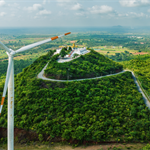IEA report offers scenarios for increased modern bioenergy use
Energy Disrupter
ADVERTISEMENT
The International Energy Agency on Oct. 27 released its World Energy Outlook 2022. The report, in part, predicts increased global use of solid bioenergy through 2050, particularly in the industrial and power sectors.
According to the IEA, approximately 60 exajoules (EJ), or 2,000 million metric tons of coal equivalent (Mtce), of solid bioenergy was used worldwide last year. The inefficient traditional use of biomass for cooking and heating in developing countries accounted for approximately 25 EJ. Africa accounted for roughly 50 percent of that amount, with Asia accounting for 45 percent.
Approximately 25 EJ of modern solid bioenergy was used last year for power generation and in end-use sectors, with 40 percent of that volume providing heat for industry, 40 percent consumed in the power sector, and 20 percent used in the building and agriculture sectors. The remaining 10 EJ was lost during conversion to solid, liquid and gaseous fuels.
The IEA’s report considers the potential for future growth in bioenergy production and use via three specific scenarios. The Stated Polices Scenario (STEPs) shows the trajectory implied by today’s policy settings, while the Announced Pledges Scenario (APS) assumes that all aspirational targets announced by governments are met on time and in full, including their long-term net zero and energy access goals. Finally, the Net Zero Emissions by 2050 (NZE) Scenario maps out a way to achieve a 1.5 degree Celsius stabilization in the rise in global average temperatures, alongside universal access to modern energy by 2030.
The STEPs scenario predicts there is limited progress on universal access to clean cooking, with the traditional use of biomass falling by only 20 percent by 2030. In 2050, 20 EJ of traditional biomass would still be used globally, with Africa accounting for 75 percent of that volume. Modern solid bioenergy use in power generation and final consumption would increase by 30 percent by 2030, with large increases in China and Europe for use in power generation.
Under the APS scenario, the traditional use of biomass falls by 60 percent from 2021 levels by 2030, and by approximately 75 percent by 2050. The remaining 6 EJ of traditional biomass in 2050 would be consumed primarily by countries in Africa. Modern solid bioenergy use in power generation and final consumption would increase by 50 percent by 2030 and more than double by 2050. The scenario predicts that approximately 1.1 gigatons (Gt) of carbon dioxide per year is captured through the use of bioenergy with carbon capture, utilization and storage (BECSS) by 2050. In total, modern bioenergy would avoid approximately 1 Gt of CO2 by 2030 and 4.5 Gt of CO2 by 2050 through the displacement of fossil fuels and the use of BECSS.
Under the NZE scenario, the traditional use of biomass would be phased out worldwide by 2030. Overall modern solid bioenergy levels would be broadly similar to those in the APS scenario, with 1.2 Gt of CO2 per year captured through BECSS by 2050. Modern solid bioenergy would avoid an estimated 1.8 Gt of CO2 emissions by 2030 and 5 Gt of CO2 emissions by 2050 through the displacement of fossil fuels and BECCS, and would be responsible for just over 10 percent of total emissions reductions in the NZE scenario, according to the IEA.
In addition to the 75 EJ of modern solid bioenergy used in 2050 under the NZE scenario, an additional 25 EJ of modern bioenergy would be used in the form of biogas or liquid biofuels. The IEA said the total bioenergy supply of 100 EJ forecasted under the scenario is at the bottom-end of the range of estimates of global bioenergy potential in 2050 and is much lower than the level of bioenergy used in comparable 1.5 degree Celsius scenarios assessed in the Sixth Assessment Report of the Intergovernmental Panel of Climate Change, which have a median of 240 EJ of bioenergy use in 2050.
Bioenergy used in the NZE scenario would come from several sources. Just over half of the 100 EJ in total modern bioenergy supply in 2050 would come from waste streams, such as agriculture residues, forest and wood residues and other organic waste streams. The remaining 45 EJ would require land to be dedicated to bioenergy supply. Short rotation woody crops could provide more than 40 EJ of bioenergy supply. Bioenergy supply from conventional crops would fall from approximately 6 EJ today to less than 1 EJ in 2050, according to the IEA.
A full copy of the report can be downloaded from the IEA website.
















